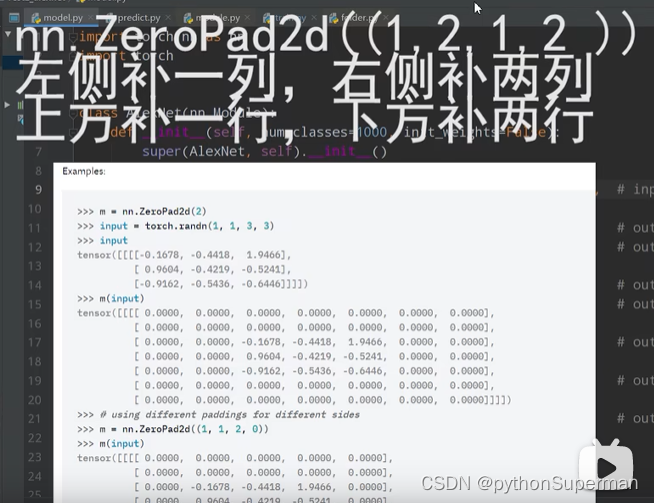概念
过拟合:根本原因是特征维度过多,模型假设过于复杂,参数过多,训练数据过少,噪声过多,导致拟合的函数完美的预测训练集,但对新数据的测试集预测结果差。 过度的拟合了训练数据,而没有考虑到泛化能力。
代码
model.py
import torch.nn as nn
import torchclass AlexNet(nn.Module):def __init__(self, num_classes=1000, init_weights=False):super(AlexNet, self).__init__()self.features = nn.Sequential(nn.Conv2d(3, 48, kernel_size=11, stride=4, padding=2), # input[3, 224, 224] output[48, 55, 55]nn.ReLU(inplace=True),nn.MaxPool2d(kernel_size=3, stride=2), # output[48, 27, 27]nn.Conv2d(48, 128, kernel_size=5, padding=2), # output[128, 27, 27]nn.ReLU(inplace=True),nn.MaxPool2d(kernel_size=3, stride=2), # output[128, 13, 13]nn.Conv2d(128, 192, kernel_size=3, padding=1), # output[192, 13, 13]nn.ReLU(inplace=True),nn.Conv2d(192, 192, kernel_size=3, padding=1), # output[192, 13, 13]nn.ReLU(inplace=True),nn.Conv2d(192, 128, kernel_size=3, padding=1), # output[128, 13, 13]nn.ReLU(inplace=True),nn.MaxPool2d(kernel_size=3, stride=2), # output[128, 6, 6])self.classifier = nn.Sequential(nn.Dropout(p=0.5),nn.Linear(128 * 6 * 6, 2048),nn.ReLU(inplace=True),nn.Dropout(p=0.5),nn.Linear(2048, 2048),nn.ReLU(inplace=True),nn.Linear(2048, num_classes),)if init_weights:self._initialize_weights()def forward(self, x):x = self.features(x)x = torch.flatten(x, start_dim=1)x = self.classifier(x)return xdef _initialize_weights(self):for m in self.modules():if isinstance(m, nn.Conv2d):nn.init.kaiming_normal_(m.weight, mode='fan_out', nonlinearity='relu')if m.bias is not None:nn.init.constant_(m.bias, 0)elif isinstance(m, nn.Linear):nn.init.normal_(m.weight, 0, 0.01)nn.init.constant_(m.bias, 0)
padding:
只能传入两种形式的变量,int整形,tuple类型。
比如int整形传入1,就会在图像的左上右下分别添上一层0。
比如tuple(1,2):1代表上下方各补一行零,2代表左右两侧各补两列零。
或者:

nn.ReLU(inplace=True):inplace=True增加计算量,减少内存使用
Dropout:失活。Dropout 是为了让全连接层部分失活,所以需要dropout的全连接层前配置Dropout()
激活:每一层都要激活。激活属于非线性操作,如果不激活,每层就是纯线性变换,连续的多层和只有一层是等效的,没有任何区别。
train.py
transform
data_transform = {"train": transforms.Compose([transforms.RandomResizedCrop(224), # 随机裁剪成224×224的大小transforms.RandomHorizontalFlip(), # 在水平方向随机水平翻转transforms.ToTensor(), # 标准化处理transforms.Normalize((0.5, 0.5, 0.5), (0.5, 0.5, 0.5))]),"val": transforms.Compose([transforms.Resize((224, 224)), # cannot 224, must (224, 224)transforms.ToTensor(),transforms.Normalize((0.5, 0.5, 0.5), (0.5, 0.5, 0.5))])}json类别文件
用flower_list来保存类别索引,在这个数据集下,图片所在的文件夹名称即为他们的索引。
然后通过dict方法联合类别和序号值
再写入json文件。
# {'daisy':0, 'dandelion':1, 'roses':2, 'sunflower':3, 'tulips':4}flower_list = train_dataset.class_to_idx cla_dict = dict((val, key) for key, val in flower_list.items())# write dict into json filejson_str = json.dumps(cla_dict, indent=4)with open('class_indices.json', 'w') as json_file:json_file.write(json_str)损失函数
loss_function = nn.CrossEntropyLoss()nn.CrossEntropyLoss():针对多类别的损失函数
优化器
optimizer = optim.Adam(net.parameters(), lr=0.0002)优化器是Adam优化器,优化对象是网络中所有的可训练的参数,学习率设置的为0.0002
net.train()
使用Dropout的方式再网络正向传播过程中随机失活一部分神经元。这是再训练过程中需要的,所以会调用net.train(),再测试过程中不需要随机失活,所以会调用net.eval()关闭dropout()方法.








)

 —— 概念、SpringBoot + MyBatis(controller+service+mapper)开发流程与过程梳理)




)
)

)
